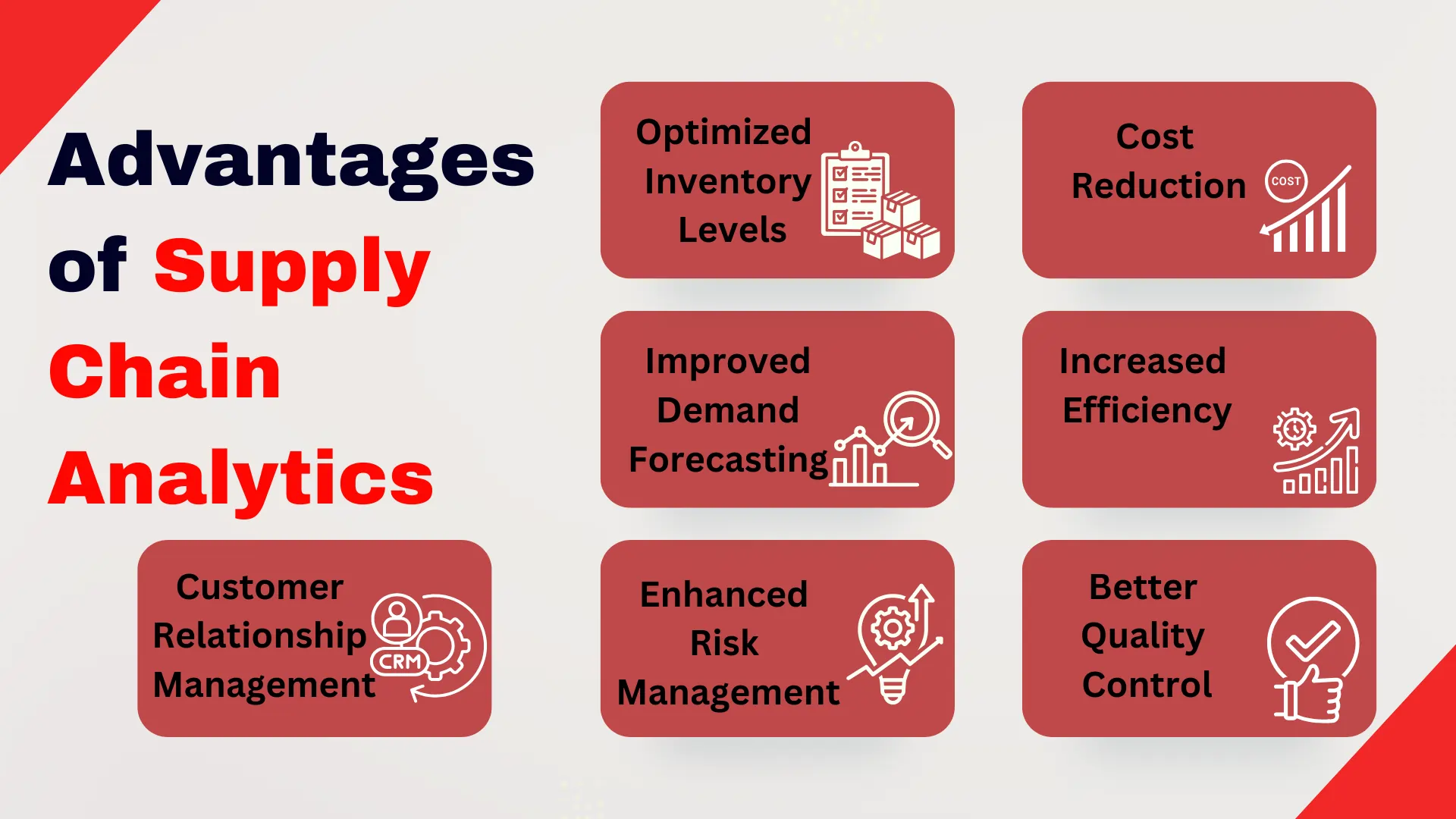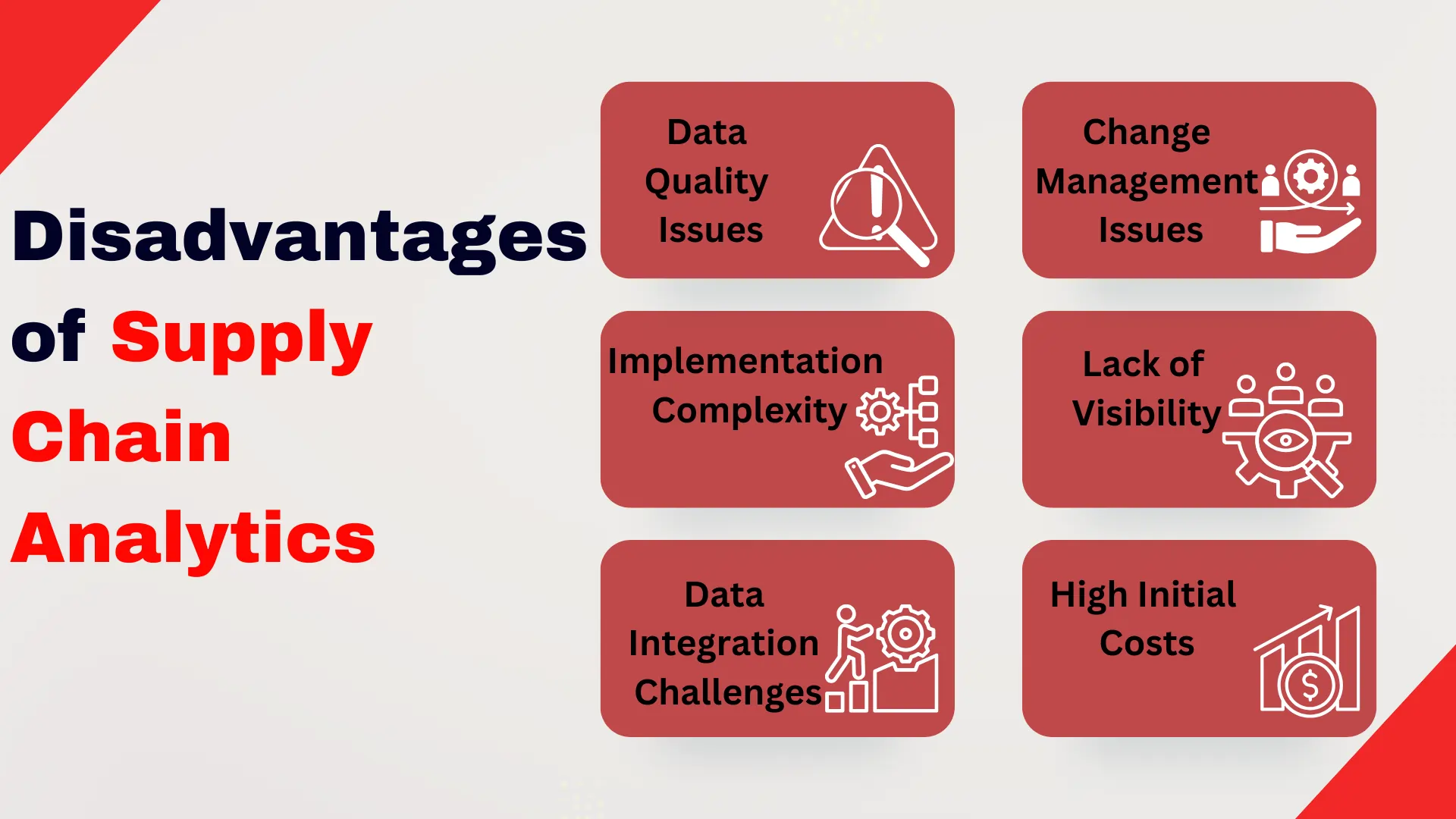Advantages and Disadvantages of Supply Chain Analytics
In today’s competitive business landscape, supply chain analytics has emerged as a critical tool for companies looking to enhance operational efficiency, reduce costs, and improve decision-making. By leveraging data-driven insights, organizations can optimize various aspects of the supply chain, from inventory management to demand forecasting. However, like any technology-driven solution, supply chain analytics comes with its own set of challenges.

Advantages of Supply Chain Analytics
Optimized Inventory Levels
Supply chain analytics allows companies to precisely estimate demand by analyzing past sales data, seasonal trends, and market variations. Companies may use this data to maintain ideal inventory levels, avoiding overstocking and stockouts. Overstocking ties up cash and raises storage expenses, whereas stockouts result in missed sales and unsatisfied consumers. Real-time tracking and automatic replenishment solutions enable organizations to dynamically alter inventory, eliminating waste and enhancing cash flow. This leads to cost savings and increased operational efficiency.
Improved Demand Forecasting
Predictive analytics allows organizations to accurately estimate demand by analyzing consumer behavior, previous purchase trends, and external market forces. Accurate forecasting enables businesses to arrange production schedules more efficiently, reducing unnecessary inventory building and ensuring that client requests are satisfied quickly. Businesses that integrate AI-powered solutions may continually enhance their estimates, minimizing reliance on manual approximations. By matching inventory levels with real market demands, the supply chain becomes more agile, waste is reduced, and profitability increases.
Enhanced Risk Management
Supply chain analytics enables companies to anticipate and manage risks by offering real-time data insights into possible disruptions. Companies can create contingency plans ahead of time for supplier delays, transportation bottlenecks, geopolitical conflicts, and natural calamities. Businesses may use AI-driven risk assessment models to diversify suppliers, improve routes, and establish backup plans to avoid interruptions. This assures smooth operations, minimizes downtime, and maintains profitability. A proactive approach to risk management improves supply chain resilience and contributes to consistent service levels.
Cost Reduction
Businesses may identify inefficiencies and reduce operating expenses by examining supply chain data. Transportation analytics, for example, assist in determining the most cost-effective delivery routes, therefore minimizing fuel usage and transit times. Warehouse management analytics maximize storage capacity utilization while decreasing rental and handling expenses. Supplier performance review guarantees that firms collaborate with cost-effective and dependable providers. Businesses may dramatically reduce costs by removing redundancies, minimizing waste, and simplifying logistics while maintaining high service standards and operating efficiency.
Increased Efficiency
Data-driven insights improve supply chain visibility. Predictive analytics allows companies to streamline procurement cycles, shorten lead times, and improve delivery schedules. Automation technologies work seamlessly with analytics to speed up order processing and inventory management. Real-time tracking enables businesses to monitor supply chain bottlenecks and take prompt remedial action. Businesses may strengthen market competitiveness by enhancing procurement, logistics, and warehouse efficiency. This reduces delays, increases productivity, and improves customer satisfaction.
Better Quality Control
Supply chain analytics allows for real-time monitoring of product quality at all stages, from raw material procurement to final delivery. Businesses may spot errors early and take rapid remedial action by collecting and analyzing data from their manufacturing processes. Artificial intelligence-powered quality control systems uncover trends in faults, allowing companies to modify procedures and enhance product consistency. Ensuring high quality standards decreases returns and customer complaints, improves brand reputation, and fosters long-term consumer trust. This results in improved client loyalty and sustained profitability.
Customer Relationship Management
Understanding client preferences through analytics helps companies to adjust their offers and improve customer experiences. Companies may create personalised marketing tactics, offer related items, and optimise pricing models by analysing purchase behaviours, demographic data, and feedback. Real-time data insights help organizations to anticipate consumer demands and provide proactive support, resulting in higher satisfaction levels. Improving customer connections through data-driven customization not only increases retention rates, but also develops brand loyalty, resulting in improved sales and long-term company success.

Disadvantages of Supply Chain Analytics
Data Quality Issues
The efficacy of supply chain analytics is strongly reliant on the quality of data gathered from several sources. Inaccurate, incomplete, or out-of-date data can produce false insights, resulting in poor decision-making and operational inefficiencies. Data inconsistencies are caused by manual mistakes, mismatched data formats, and disparities across numerous systems. Businesses may struggle to receive trustworthy analytics if their data is not properly validated and cleansed. To address these concerns, companies require strong data governance rules, automated data validation procedures, and regular audits.
Implementation Complexity
Implementing supply chain analytics necessitates significant investment in modern technology, infrastructure, and specialized labor. Organizations must connect analytics solutions with current enterprise systems, which may be time-consuming and technically challenging. Additionally, personnel require specific training to efficiently utilize these technologies, which adds to the learning curve. Poorly performed implementations might cause interruptions in ongoing operations. To guarantee a successful transition, businesses must carefully plan the launch, engage in change management, and give ongoing support to staff.
Data Integration Challenges
Suppliers, manufacturers, logistics providers, and retailers are all involved in supply chains, and each uses their own data system. Integrating data from these disparate sources into a single analytics platform is a considerable hurdle. Differences in data formats, storage techniques, and reporting patterns might result in inefficiencies and delays. Without seamless data integration, firms struggle to acquire a comprehensive perspective of their supply chain activities. To solve this, businesses require modern integration technologies, standardized data formats, and close coordination with partners.
Change Management Issues
Employees who are accustomed to old procedures may oppose the transition to data-driven decision-making. Many employees may be suspicious of analytics technologies, fearing job loss or additional complexity in their operations. Without enough communication and training, adoption rates may stay low, decreasing the usefulness of supply chain analytics. To solve this, companies must establish organized change management tactics, such as staff training, stakeholder involvement, and continuous feedback systems, to ensure a seamless and effective transition to analytics-based operations.
Lack of Visibility
Supply chain analytics generates actionable insights based on full and real-time data. However, if firms use fragmented or siloed systems, visibility throughout the supply chain is limited. Incomplete data can result in inaccurate forecasts, inefficient inventory management, and ineffective decision-making. Without complete connectivity, businesses may struggle to manage shipments, supplier performance, and demand variations. Investing in cloud-based platforms, IoT sensors, and end-to-end supply chain visibility solutions may help close data gaps and increase operational transparency.
High Initial Costs
Implementing an effective supply chain analytics system requires a large financial commitment. Businesses must buy advanced analytics tools, enhance their IT infrastructure, and recruit talented data workers. Furthermore, integrating with current corporate systems may necessitate special development, raising expenses. While analytics can result in long-term cost savings and efficiency advantages, the significant upfront costs can be a huge impediment, especially for small and medium-sized businesses. Companies must carefully assess the return on investment (ROI) and phased deployments in order to efficiently control expenditures.

Conclusion
Supply chain analytics provides businesses with useful insights into optimizing operations, increasing efficiency, and lowering costs. Despite its various benefits, businesses must be prepared to face problems like as data integration, implementation difficulty, and high upfront expenses. Businesses may maximize the promise of analytics by investing in robust technology, educating workers, and taking a strategic approach. A well-executed supply chain analytics strategy leads to better decision-making, higher resilience, and a stronger competitive advantage in today’s dynamic market.
Thanks For Reading: Advantages and Disadvantages of Supply Chain Analytics
Powered By 360Presence

